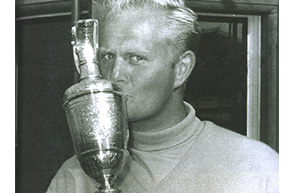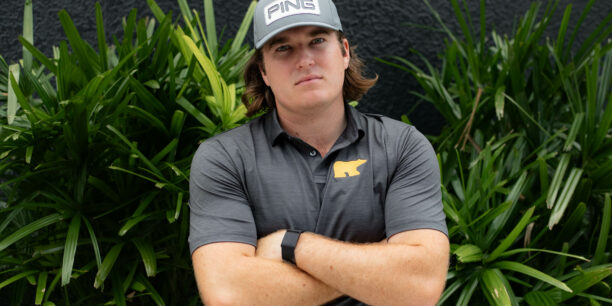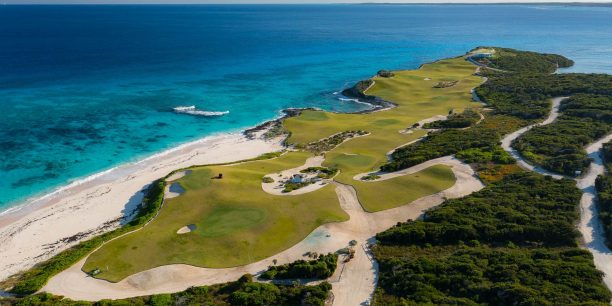Jack Nicklaus achieves the career Grand Slam with his victory in the 1966 British Open.
He was only 26 years old, in his fifth year as a professional, and yet the Open Championship had already become an elusive prize in the meteoric career of Jack Nicklaus.
By the summer of 1966, the man known as the Golden Bear had won five professional major championships—a total that would eventually climb to a record 18—yet the Claret Jug had remained out of his reach and hoisting it in victory was the only signature moment left from Nicklaus’ pursuit of the career “Grand Slam.”
That was, until, July 9, 1966, when on the storied links of Muirfield in Scotland, Jack Nicklaus finally won the Open Championship, and joined an iconic group of champions—Gene Sarazen, Ben Hogan and Gary Player who were at that point in golf history the only three players to claim all four majors.
When it came time to accept the Claret Jug, a typically stoic Nicklaus—at least inside the ropes—became overwhelmed with emotion and his words were choked by tears.
“Excuse me,” he said to those gathered. “Do you mind if I just enjoy this moment?”
Nicklaus vividly recalled the moment decades later.
“When the moment came to accept the trophy,” Nicklaus said, “the tears began welling up and I couldn’t get any words out. Being about to receive something that even I, never much of a self-doubter, had genuinely doubted would ever be mine, was extremely emotional. Finally, I asked the people to excuse me and to let me just stand there and enjoy myself for a moment. It’s a moment I still enjoy recalling as much as any in my career.”
As if any doubt remained about the uniquely special place this victory enjoyed in the Golden Bear’s career, just a few years following his Open Championship win, Nicklaus designed and opened in 1974 his Ohio home club in Dublin, outside of Columbus, choosing the name Muirfield Village Golf Club to pay homage to the famed Scottish layout and significant milestone.
“My philosophy, particularly since the 1966 Open Championship, is that golf is principally a game of precision: that you will score your best when you map and then play your way through each hole most intelligently. For many years now, that is how I have designed my courses,” Nicklaus said, a not-so-subtle nod to the strategy at his Muirfield Village, indeed.
Scotland’s Muirfield is renowned by many as perhaps the fairest test of all the Open venues, with few of the quirky bounces and hidden dangers that links courses often contain. The nines rotate in opposite directions, the back nine looping inside the front nine, ensuring that the golfer is never faced with the same wind direction on two consecutive holes.
Nicklaus was more than motivated to win the 1966 Open Championship. Since turning pro in 1962, the Golden Bear had victories in the U.S. Open (1962), the Masters (1963, ’65, ’66), and the PGA Championship (1963). But the Open Championship title had so far evaded the five-time major champion. His yearning for the title that year also grew out of simply playing the famed host course, which he considered to be the Open Championship venue which best suited his game.
“I think of all the British rota, Muirfield is probably the most American-type golf course,” Nicklaus said. “It’s set up the way I like to play. It’s set up where the bunkering is actually very strategic. It’s common sense bunkering to me. There aren’t a lot of silly bunkers set up all over the place that grab everybody. It’s set up pretty much how we could call a ‘normal’ golf course would be set up. I just always liked it.”
Returning to the links layout on East Lothian was a homecoming of sorts for Nicklaus. It was where he had made his maiden voyage to Scotland in 1959. That was the year Nicklaus, then just a 19-year-old sophomore at Ohio State, would begin his life-long love affair with links golf and the royalty of Scottish golf. As a member of the visiting Walker Cup team, Nicklaus made the trans-Atlantic flight and arrived late that next afternoon at Graywalls. Despite fatigue, he was spellbound by Muirfield at first glance.
“It was such a glorious evening, the sun spilling over the links, that we forgot our tiredness, changed into our golf gear, and charged out to play nine holes before dinner,” he recalled in The Greatest Game of All, his first biography, penned by the great Herbert Warren Wind.
“From the beginning, I liked Muirfield very much,” Nicklaus said. “I think we all did. While it has the intrinsic qualities of a British seaside links — fairways that tumble every which way, magnificent low-cropped turf, deep bunkers, and hard, unwatered greens — it is a frank and open course. There were something like 190 bunkers at Muirfield, but they were all visible.”
Nicklaus, who won both his matches that week at the Walker Cup and then later in the summer of 1959 won his first U.S. Amateur title, gave credit to the experience as a key moment in his amateur career.
“After Muirfield, I had a deeper confidence in my ability to produce a good golf shot when I had to… and more confidence, too, about my capacity to function under pressure,” he said.
Nicklaus’ first return to Great Britain did not come until 1962 and his first Open Championship as a professional. And in his first four attempts, the Golden Bear had no wins and only mixed results.
By the time he finished 12th in 1965 at Royal Birkdale—the site of this month’s Open Championship—critics began to question whether Nicklaus’ playing style and high ball flight could win an Open, where taming the often unpredictable seaside breezes are integral to the challenge. Nicklaus adopted a positive attitude when he came to Muirfield that next summer in 1966. He not only remembered fondly his Walker Cup experience, but having won the Masters for the third time in four years in April, he was now a seasoned veteran, and for the first time in his career, he was labeled the No. 1 player in the world.
As he famously did during his major championship career, Nicklaus arrived a week early to adjust to the climate. But no amount of time could have prepared the Golden Bear for the Muirfield that awaited him.
“When I arrived for the Open in ’66, Muirfield didn’t look anything like the golf course I remembered from seven years earlier,” he said. “All of a sudden, we saw knee-high rough and narrow fairways. Finding your golf ball in the rough was almost impossible. Not only that, if you set your bag down, you’d lose your bag. And if you had a short caddy, you’d lose him, too!”
Gerald Micklem, the former chairman of the R&A’s Championship Committee, was convinced that Muirfield didn’t possess the necessary length for the Open, so he and his committee decided not to cut the fairway rough the entire year. In many places, the fairways narrowed to only 20 yards wide. Nicklaus would have no choice but to sacrifice distance for precision off the tee with his 3-wood or long irons.
“Everyone felt it was a golf course not set up for Jack Nicklaus, as it took the driver out of my hands and negated the power advantage I had over the field back then,” Nicklaus said. “The winner that week was going to be someone who hit the ball straight, kept it in play, and put together four disciplined rounds of golf. Well, I had to make Jack Nicklaus very disciplined.”
As the practice rounds played out, the Golden Bear began to identify the number of holes where he could safely use a driver. And by the time he began the first round, he was left with only the par-5 fifth hole and only a handful of long par 4s. By week’s end, Nicklaus used his driver — the club that arguably best defined his game in the 1960s — only 17 times.
“I was determined to do whatever I had to do to put the ball in play from the tee because Muirfield is relatively open in front of the greens, and allows you to bounce the ball in fairly easily if you are playing your second shot from the short grass,” he added. “Distance was not an issue; playing within yourself was.”
Eventually, course management would define the championship career of Jack Nicklaus—far more than his prodigious length of the tee would. Using driver only sparingly that week in Muirfield became a microcosm of the Golden Bear’s brilliance, where equal doses of humility mixed with self-confidence and self-analysis of his game. This allowed the still-young Nicklaus to evolve from amateur days highlighted by frightening power and the ability to overpower a golf course.
Nicklaus took the lead with scores of 70 and 67; however, he dropped four shots in the last five holes for a 75 in the third round and fell behind fellow American Phil Rodgers.
Nicklaus took control again by going out in 33 in the final round, while Rodgers slumped to a 76 and Arnold Palmer fell out of contention with a 7 at the 10th hole. The colorfully attired American Doug Sanders, who the Golden Bear later beat in a playoff at St. Andrews for his second Open Championship win, chipped in from 60 yards for an eagle at the ninth only to take a 6 at the 11th. Sanders finished with a 70 to tie Dave Thomas, the Welshman collecting two 2s and a 3 coming home for a 69.
Nicklaus, after three bogeys in four holes from the 11th, needed to play the last two holes with a pair of 4s and duly secured a birdie at the 17th.
When Nicklaus carefully two-putted from 25 feet for par on the final green at Muirfield on July 9, 1996, his championship dream of the Grand Slam had been realized.




